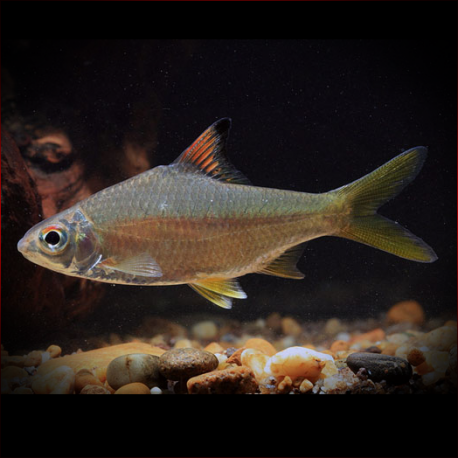More info
Datasheet
| Minimum Tank Size | 240 litres / 63.40 US gallons |
| Maximum Size | 14.0cm / 5.51inches |
| Temperature | 20°C / 68.00°F - 27°C / 80.60°F |
| Hardness | 2.02dgH / 36ppm - 15.02dgH / 268ppm |
| pH | 6.0-7.5 |
General Description
The Mystacoleucus Argenteus, also known as the Burmese Rainbow Barb in the ornamental trade, can be distinguished from its congener M. obtusirostris by certain features. Featuring a silvery body with shades of lilac and blue, it lacks the black-edged scales that the M. obtusirostris possesses. Described with details by Day in 1888, this species has specific physical characteristics such as a blunt snout, compressed body, and fin colors ranging from orange-scarlet to lemon-yellow. All Mystacoleucus species, including the M. Argenteus, have a unique predorsal spine that requires careful handling to avoid entanglement.
Aquarium Setup
To keep the Mystacoleucus Argenteus thriving in captivity, a tank resembling a flowing stream or river is recommended. The tank should have a substrate of rocks, sand, and gravel, along with driftwood and aquatic plants like Microsorum and Anubias. Water quality is crucial for this species, requiring spotless conditions to mimic its natural pristine habitat. While high oxygen levels and moderate water movement are beneficial, weekly water changes of 30-50% aquarium volume are essential.
Behaviour
The Mystacoleucus Argenteus is generally not aggressive but can perturb slow or timid tankmates, particularly during feeding. It is best housed with robust, similarly-sized companions such as cyprinids, loaches, and other riverine fishes. In the wild, this species forms schools, so maintaining a group of six or more individuals is recommended for their well-being. When creating a Salween-themed community tank, suitable tankmates include Devario aequipinnatus, Rasbora daniconius, and Pethia stoliczkana, among others.
Feeding and Diet
In their natural habitat, Mystacoleucus Argenteus are likely omnivores, feeding on insects, crustaceans, worms, algae, and aquatic plants. In captivity, they readily accept a diet of live and frozen foods like bloodworms, Daphnia, and Artemia, supplemented with high-quality dried flakes containing plant materials such as Spirulina. Regular feeding is essential for maintaining optimal condition and health in these fish.
Reproduction & Dimorphism
Limited information is available regarding the reproduction of Mystacoleucus Argenteus. Sexually mature females are speculated to have a deeper body compared to males. Further studies are needed to understand the breeding behavior and dimorphic characteristics of this species in detail.
Habitat and Distribution
The Mystacoleucus Argenteus is native to the lower Salween River basin in southern China, Myanmar, and western Thailand. It can be found in well-oxygenated, fast-flowing waters with sandy or gravelly substrates, often inhabiting rocky streams and larger river channels. The species' type locality is described as the streams within the Tenasserim District in Myanmar.

